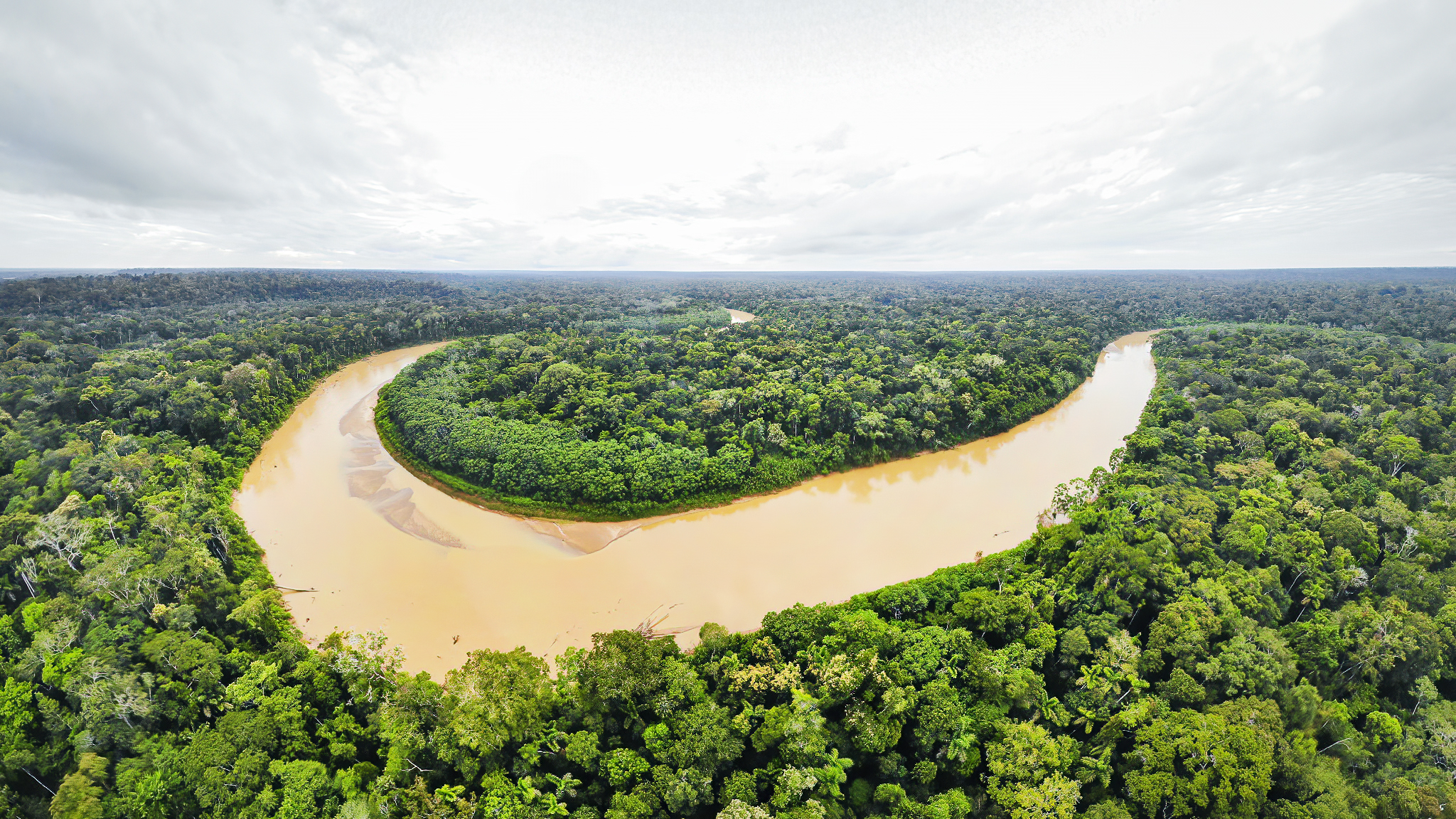Want to protect the Amazon? Consider visiting a research station
I recently spent five nights at Los Amigos Biological Station, a conservation hub deep in the jungles of the Peruvian Amazon. The station itself is spectacular – simple, off-the-grid accommodation surrounded by kilometres of walking trails through beautiful, pristine rainforest. During the day, multicoloured macaws soar overhead, and playful primates swing through the treetops; and if you’re brave enough to head out at night, that’s when the jungle truly comes alive. There are bioluminescent mushrooms, frogs with horns, agricultural ants, and elusive big cats that you probably won’t see, but that will almost definitely see you.

Whilst at Los Amigos, I had the privilege of accompanying Consuelo Alarcón – the station’s Science Coordinator – on two long walks through the jungle. We discussed the history of Los Amigos, its current challenges, and Consuelo’s own journey in the world of conservation. Our conversations were constantly interrupted by – “Wow! Check this out! It’s so beautiful!” – as some captivating creature would steal our attention, and Consuelo would generously share her wealth of knowledge on the jungle’s wildlife.
“I’m a biologist, I love frogs and snakes,” she says, as we begin walking through the dense rainforest, pitch black but for our headlamps lighting up the path in front of us, “but this world has also involved me in activism. I try my best to ensure my activities in science have the minimum negative impact on the environment – not because I’m a biologist, but because I’m a human being.”
Consuelo has been in her role for just over three months, and she comes to Los Amigos after founding a successful composting project in Cusco. Qosqomposta, a play on the Indigenous Quechua spelling of Cusco, is a not-for-profit that collects people’s organic waste, composts it, and then gives it back to families either in the form of fertiliser for them to grow their own produce, or as vegetables grown in Qosqomposta’s own gardens.
Today, her role entails a much greater level of responsibility, coordinating between park rangers, researchers, student groups, as well as staff at the Asociación para la Conservación de la Cuenca Amazónica (ACCA) – the organisation which owns the station.
“My goal is to produce a community of science, which I’m learning how to do every day. It’s very exciting, and it’s always challenging. I’m not getting bored at all.”

However, the challenges facing Los Amigos extend far beyond Consuelo’s mandate.
Los Amigos consists of both a research station and a larger conservation area. The research station is a few hundred hectares in size, but it pales in comparison to the conservation area, which is almost 150,000 hectares – more than twice the size of Singapore.
This region also forms an important buffer zone for protected areas to the north-east that contain 15 of the estimated 100 uncontacted tribes that remain in the world today. These nomadic communities, which live deep in the jungles of the Peruvian Amazon, have almost zero contact with the outside world, and preserving their right to live in isolation is a high priority for the Peruvian government.
Established in 2000, Los Amigos is a Conservation Concession. “The government owns the land, but it gives the management to others for certain purposes,” Consuelo explains. The Peruvian Government allocates land to private organisations for a wide range of purposes, from conservation and tourism, to logging and mining. However, as you might expect, the latter industries don’t always respect these boundaries.
The perennial threat facing Los Amigos and areas like them is selective logging – the process of illegally entering conservation concessions and cutting down individual trees, typically targeted for their high monetary value. Of particular interest is the mighty Shihuahuaco (Dipteryx micrantha). These enormous trees grow up to 60 metres tall and can be hundreds, sometimes thousands of years old.
However, in the last decade, demand for their wood has grown exponentially, due to their use in parquet flooring. Loggers illegally enter conservation areas and identify the largest, oldest Shihuahuaco trees, before returning with a team to rapidly cut down and remove the selected target.
“It’s pathetic,” says Consuelo, “how can we kill an individual that has been here for five hundred years, minimum, just to have it as your floor?”
The process also has devastating knock-on effects for the surrounding rainforest, and for the planet as a whole. Shihuahuacos play an important role in the lives of countless animals, from bats and monkeys, to eagles and macaws, and they also remove massive amounts of carbon dioxide from the atmosphere. A single mature Shihuahuaco typically accounts for around a third of the CO2 sequestered by an average hectare of rainforest.

However, another challenge poses an even more immediate and dire threat to the Peruvian jungles – gold mining. During the 1970s, the price of gold rose to its highest point ever, and mining in the region exploded. But in the two decades that followed, gold markets crashed and the boom subsided. Since the turn of the century, however, gold prices have steadily risen to just shy of their 1970s high, and illegal gold mining has rapidly expanded once more in the Peruvian Amazon.
Reaching Los Amigos Biological Station involves a three-hour boat ride along the Rio Madre de Dios, and for the entire journey, I watched as we passed countless makeshift gold mines nestled along the banks of the river. A few days later I would speak with an American professor who’d been here just four years earlier, and who remembered that same boat ride being spectacular, packed with wildlife. This time around, neither of us had seen a single non-human animal.
Similarly, the research station has an incredible clifftop lookout. Your foreground is filled by the mighty Madre de Dios, and behind it, the rainforest stretches out to the horizon in all directions. However, the sight is today soured by one of the larger gold mines I saw. It stares back at you from the opposite bank of the river, and the constant whir of its machinery often drowns out the sounds of the jungle.
The speed at which these mines are expanding is difficult to comprehend. “The ones in front of us only started in October,” Consuelo informs me, “back in the day, you needed the ACCA boat to get to this part of the forest – now there are public boats.”
It was at this point I decided that I wanted to photograph the mining activity on my return trip, and work on putting together a piece exploring the issue. I asked Consuelo if she knew of anyone that had visited any of the mines.
“I guess you didn’t understand,” she said, taking a suddenly serious tone, “that whole business is worth a lot of money in Peru. They don’t want any journalists, any photographers, nothing. Even among the miners, it’s very dangerous. If somebody new goes to work there, and somebody doesn’t like them, they can kill them – nobody is going to respond to it. The mining areas are lawless, there’s no police or anyone you can complain to… It’s a serious social issue.”
More than two-thirds of murders of environmental activists globally occur in Latin America. Colombia, Brazil and Mexico remain the most dangerous areas to speak out – these three nations saw the deaths of 207 activists in 2021, and Colombia alone has reported 52 murders in just the first three months of this year. While Peru is one of the tamer countries in the region, it certainly isn’t without its share of violence – with 220 activists murdered since 2011.

A few days later, my time at Los Amigos had come to an end, and I was back in the boat. We’d been floating down the Rio Madre de Dios for an hour or so, and I had plenty of photos of the mines themselves – they were everywhere after all. However, despite Consuelo’s warning, the story still needed a human face.
The boats are aquatic versions of the colectivo buses you find throughout South America – essentially communal taxis that can be waved down at any time. As we continued downstream, a worker at one of the mines flagged us over. No one joined us, they just wanted a piece of machinery transported back to Puerto Laberinto, the nearest town.
As our boat approached, one of the miners stood out to me. He could obviously just pass for 18, although I highly doubt that he was, and he was standing in a rusty old 55-gallon steel drum. Covered in dirt and wearing nothing but a pair of shorts, he was continuously stomping in the hopes of separating gold from sediment in the base of the barrel. He looked like a bleak, industrial version of a rustic Italian winemaker.
This was the human face of illegal Peruvian mining that I’d been trying to find.
“¿Amigo, puedo tomar tu foto por favor?”
Until now, every single Peruvian I’d asked to take a photo of had responded with complete enthusiasm, more than happy to oblige – and I expected this interaction to be the same.
The miner looked up, and without a word simply shook his finger at me, as a wry smile spread across his face.
The reality of the situation hit home in that moment. The miners along the banks of the Rio Madre de Dios were among Peru’s poorest individuals. The young man in front of me knew he wasn’t supposed to be there, and he also knew that even a single photo of him could jeopardise what little income he could provide to his family.
As our boat pulled away, my heart sank as I thought about the countless others I’d seen in similar situations that day. How many of them would have enough food on the table that night?

For conservationists and environmentalists in developed nations, it’s easy to look at mining and logging in the Amazon as a black and white issue. Of course we need to protect the rainforest, these activities must be stopped – end of story. But on the ground, the complexity of the grey space comes to the fore.
Protecting the Amazon isn’t an environmental issue. It’s a profoundly human one.
Los Amigos Biological Station has just 12 rangers to guard 150,000 hectares of pristine rainforest, and they are fighting a losing battle against selective logging and gold mining. When illegal activity is spotted, the rangers aren’t allowed to intervene. They’re only permitted to report the activity to police and military services, who can take days to arrive, if they respond at all. By this point, particularly when it comes to logging, those involved have already well and truly disappeared, often leaving nothing but a thousand-year-old stump behind.
The unfortunate reality is that barring major changes to our political and economic systems, the best way to preserve the Amazon today is to make protecting it more profitable than destroying it. So if you want to save the jungle, go and see it. Show those tearing it down that there’s more money to be made by leaving it as it is – because currently, the financial incentive to protect the rainforest simply isn’t there.
Despite the enormity of the challenges facing Los Amigos, for the five days I stayed at the station, I had a six-bed dorm all to myself. Research stations like this exist in almost every corner of the globe that you find impressive biological diversity, and while they rarely advertise, most are more than happy to accommodate you if you reach out and send them an email.
If you’re backpacking, a few days at a research station or conservation project might cost a bit more than your average hostel, but it certainly won’t break your budget; and if you’re on holidays and staying in hotels – you’ll probably save money, and have a much more authentic experience in the process.
Most importantly, in either case, you’ll know that your money is protecting the planet’s most vulnerable natural areas in a very real and direct manner, and that your actions are sending a strong message to miners and loggers that if they want to provide for their families, they are in the wrong business.


